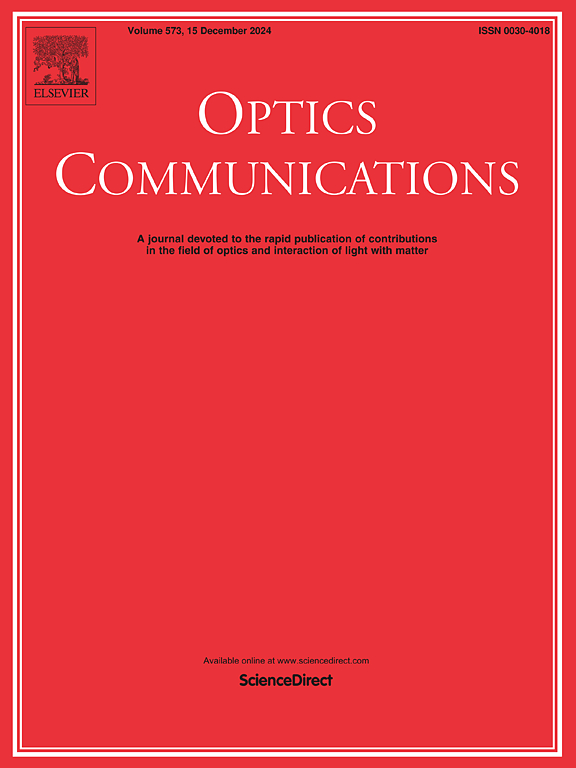量子力学莫辛斯基效应的经典类比:色散衰减光纤中矩形激光脉冲梯度干涉效应的“拉伸”和“冻结”
IF 2.5
3区 物理与天体物理
Q2 OPTICS
引用次数: 0
摘要
我们研究了瞬态量子力学莫辛斯基效应的经典光学类似物,也被称为“时间衍射”,它可以在矩形超高斯激光脉冲和光束的线性传播动力学中观察到。我们发现在脉冲前沿和光束边缘处存在临界场梯度,此时菲涅耳型衍射图案完全填满了超高斯场轮廓的平顶,它们的干涉导致线性色散/衍射“自聚焦”效应。我们表明,“自聚焦长度”和相应的有效“增益”对场梯度的陡峭度的依赖关系表现出趋于饱和的趋势。我们强调,基于Schrödinger-type方程的准光学计算建模的准确性必须始终由普通空间/时间和傅里叶谱域的主要守恒定律控制。特别地,我们证明了在超高斯脉冲和光束的线性动力学中产生的显着菲涅耳型衍射图案伴随着其完全平稳的傅立叶谱分布,其计算精度高达8个数量级。由于所考虑的量子力学莫辛斯基效应的光学类似物仅在与色散和衍射长度相比相当小的距离上表现出来,因此我们将重点放在非自治系统中这些特征的可能实验实现上,其中一个典型的例子是群速度色散沿光纤长度减小的光纤。我们发现,色散衰减光纤提供了一个独特的机会,可以减缓(“拉伸”)超高斯脉冲平顶处莫辛斯基型色散模式的形成,甚至“冻结”矩形激光脉冲中心部分的线性梯度干涉“自聚焦”。本文章由计算机程序翻译,如有差异,请以英文原文为准。
Classical analogues of the quantum-mechanical Moshinsky effect: “Stretching” and “freezing” of gradient interference effects for rectangular-shaped laser pulses in dispersion-decreasing optical fibers
We study classical optical analogues of the transient quantum mechanical Moshinsky effect, also known as “diffraction in time”, which can be observed in the linear propagation dynamics of rectangular-shaped super-Gaussian laser pulses and beams. We find critical field gradients at the pulse fronts and beam edges, at which the Fresnel-type diffraction patterns completely fill the flat top of the super-Gaussian field profile, and their interference leads to the linear dispersive/diffractive “self-focusing” effect. We show that the dependencies of both the “self-focusing length” and the corresponding effective “gain” on the steepness of the field gradients demonstrate a tendency towards saturation. We highlight that the accuracy of quasioptical computational modeling based on the Schrödinger-type equations must always be controlled by the principal conservation laws in both ordinary space/time and the Fourier spectral domains. In particular, we demonstrate that significant Fresnel-type diffraction patterns arising in the linear dynamics of super- Gaussian pulses and beams are accompanied by their completely stationary Fourier spectral distributions calculated with an accuracy up to 8 orders of magnitude. Since the considered optical analogues of the quantum-mechanical Moshinsky effect manifest themselves only at the rather small distances compared to the dispersion and diffraction lengths, we concentrate on possible experimental realizations of these features in nonautonomous systems, a typical example of which is represented by the optical fiber with group velocity dispersion decreasing along the fiber length. We reveal that dispersion-decreasing optical fibers provide a unique opportunity to slow down (“stretch”) the formation of the Moshinsky-type dispersion patterns at the flat tops of super-Gaussian pulses and even “freeze” the linear gradient interference “self-focusing” of the central parts of rectangular-shaped laser pulses.
求助全文
通过发布文献求助,成功后即可免费获取论文全文。
去求助
来源期刊

Optics Communications
物理-光学
CiteScore
5.10
自引率
8.30%
发文量
681
审稿时长
38 days
期刊介绍:
Optics Communications invites original and timely contributions containing new results in various fields of optics and photonics. The journal considers theoretical and experimental research in areas ranging from the fundamental properties of light to technological applications. Topics covered include classical and quantum optics, optical physics and light-matter interactions, lasers, imaging, guided-wave optics and optical information processing. Manuscripts should offer clear evidence of novelty and significance. Papers concentrating on mathematical and computational issues, with limited connection to optics, are not suitable for publication in the Journal. Similarly, small technical advances, or papers concerned only with engineering applications or issues of materials science fall outside the journal scope.
 求助内容:
求助内容: 应助结果提醒方式:
应助结果提醒方式:


